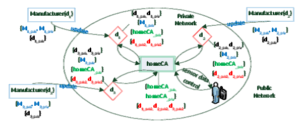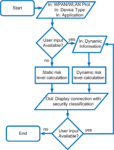General audience texts
Besides the scholarly publications listed below, I have written many texts in English and German. My more notable German texts appeared by DNIP.ch. I also maintain document collections intended for a broad audience:
Scholarly publications
Up-to-date citation counts (provided by Google Scholar). List of patents granted.
2019
Robert Müller; Corinna Schmitt; Daniel Kaiser; Marcel Waldvogel
HomeCA: Scalable Secure IoT Network Integration Proceedings Article
In: Stumme, David; Geihs; Lange; (Ed.): INFORMATIK 2019, pp. 167-180, Gesellschaft für Informatik, 2019.
Abstract | BibTeX | Tags: Internet of Things, Security, Wireless | Links:
@inproceedings{mueller2019homeca,
title = {HomeCA: Scalable Secure IoT Network Integration},
author = {Robert Müller; Corinna Schmitt; Daniel Kaiser; Marcel Waldvogel},
editor = {David; Geihs; Lange; Stumme},
url = {https://netfuture.ch/wp-content/uploads/2019/09/mueller2019homeca.pdf},
year = {2019},
date = {2019-09-25},
urldate = {1000-01-01},
booktitle = {INFORMATIK 2019},
journal = {INFORMATIK 2019},
volume = {P-294},
pages = {167-180},
publisher = {Gesellschaft für Informatik},
series = {LNI},
abstract = {Integrating Internet of Things (IoT) devices into an existing network is a nightmare. Minimalistic, unfriendly user interfaces, if any; badly chosen security methods, most notably the defaults; lack of long term security; and bugs or misconfigurations are plentiful. As a result, an increasing number of owners operate unsecure devices.
Our investigations into the root causes of the problems resulted in the development of Home Certificate Authority (HomeCA). HomeCA includes a comprehensive set of secure, vendor-independent interoperable practices based on existing protocols and open standards. HomeCA avoids most of the current pitfalls in network integration by design. Long-term protocol security, permission management, and secure usage combined with simplified device integration and secure key updates on ownership acquisition pave the way toward scalable, federated IoT security.},
keywords = {Internet of Things, Security, Wireless},
pubstate = {published},
tppubtype = {inproceedings}
}
Our investigations into the root causes of the problems resulted in the development of Home Certificate Authority (HomeCA). HomeCA includes a comprehensive set of secure, vendor-independent interoperable practices based on existing protocols and open standards. HomeCA avoids most of the current pitfalls in network integration by design. Long-term protocol security, permission management, and secure usage combined with simplified device integration and secure key updates on ownership acquisition pave the way toward scalable, federated IoT security.

2017
Robert Müller; Marcel Waldvogel; Corinna Schmitt
MoDeNA: Enhancing User Security for Devices in Wireless Personal and Local Area Networks Technical Report
Distributed Systems Laboratory, University of Konstanz no. KN-2017-DISY-02, 2017.
Abstract | BibTeX | Tags: Internet of Things, Security, Usability, Wireless, WPAN | Links:
@techreport{Mueller2017MoDeNA,
title = {MoDeNA: Enhancing User Security for Devices in Wireless Personal and Local Area Networks},
author = {Robert Müller and Marcel Waldvogel and Corinna Schmitt},
url = {https://netfuture.ch/wp-content/uploads/2017/03/kn-2017-disy-02.pdf},
year = {2017},
date = {2017-03-13},
urldate = {1000-01-01},
number = {KN-2017-DISY-02},
institution = {Distributed Systems Laboratory, University of Konstanz},
abstract = {Today most used devices are connected with each other building the Internet
of Things (IoT). They communicate with each other directly and share data with
a plethora of other devices indirectly by using the underlying network infrastruc-
ture. In both cases a variety of protocols are used depending on infrastructure,
application (e.g., Smart City, eHealth), and device capability. But the overall
concept of the data sharing is to do it in a secure manner so that different users
(e.g., consumer, facilities, provider) can gain benefits. But what does “secure
manner” means? This is a big question between the stakeholders, especially when
talking of wireless personal and local area networks (WPANs) and wireless local
area networks (WLAN), because the judgment of the security feeling depends
on personal settings (e.g., easy to use, encrypted transmission, anonymization
support). Therefore, MoDeNA – a Mobile Device Network Assistant – was de-
veloped offering an opportunity for understanding the judgment of security by
bringing the user’s concerns and their technology understanding of used devices
and protocols into relation. MoDeNA provides a transparent overview over the
used wireless security of the user’s device giving concrete advices for improving
the connection security, helping to improve usability of mobile device security. As
a use-case the smart city environment is used, because this is the most common
area, where many different WPAN and WLAN connections exist, supported by
different underlying infrastructures, and where secure data transmission is es-
sential, because it is an “open communication area”.},
keywords = {Internet of Things, Security, Usability, Wireless, WPAN},
pubstate = {published},
tppubtype = {techreport}
}
of Things (IoT). They communicate with each other directly and share data with
a plethora of other devices indirectly by using the underlying network infrastruc-
ture. In both cases a variety of protocols are used depending on infrastructure,
application (e.g., Smart City, eHealth), and device capability. But the overall
concept of the data sharing is to do it in a secure manner so that different users
(e.g., consumer, facilities, provider) can gain benefits. But what does “secure
manner” means? This is a big question between the stakeholders, especially when
talking of wireless personal and local area networks (WPANs) and wireless local
area networks (WLAN), because the judgment of the security feeling depends
on personal settings (e.g., easy to use, encrypted transmission, anonymization
support). Therefore, MoDeNA – a Mobile Device Network Assistant – was de-
veloped offering an opportunity for understanding the judgment of security by
bringing the user’s concerns and their technology understanding of used devices
and protocols into relation. MoDeNA provides a transparent overview over the
used wireless security of the user’s device giving concrete advices for improving
the connection security, helping to improve usability of mobile device security. As
a use-case the smart city environment is used, because this is the most common
area, where many different WPAN and WLAN connections exist, supported by
different underlying infrastructures, and where secure data transmission is es-
sential, because it is an “open communication area”.


